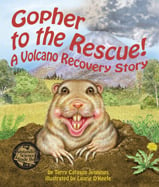Alignment to Standards for MI

| Grade | Number | Standard |
|---|---|---|
| 1 | 1 _ G1.0.4 | Distinguish between landmasses and bodies of water using maps and globes. |
| 1 | L.HE.01.11 | Identify characteristics (for example: body coverings, beak shape, number of legs, body parts) that are passed on from parents to young. |
| 1 | L.OL.01.13 | Identify the needs of animals. |
| 1 | L.OL.E.1 | Animals and plants need air, water, and food. Plants also require light. Plants and animals use food as a source of energy and as a source of building material for growth and repair. |
| 2 | E.SE.02.21 | Describe the major landforms of the surface of the Earth (mountains, plains, plateaus, valleys, hills). |
| 2 | E.SE.E.2 | The surface of Earth changes. Some changes are due to slow processes, such as erosion and weathering, and some changes are due to rapid processes, such as landslides, volcanic eruptions, and earthquakes. |
| 2 | L.HE.02.13 | Identify characteristics of plants (for example: leaf shape, flower type, color, size) that are passed on from parents to young. |
| 2 | L.OL.E.1 | Animals and plants need air, water, and food. Plants also require light. Plants and animals use food as a source of energy and as a source of building material for growth and repair. |
| 3 | E.SE.E.1 | Earth materials that occur in nature include rocks, minerals, soils, water, and the gases of the atmosphere. Some Earth materials have properties which sustain plant and animal life. |
| 3 | L.EV.03.12 | characteristics and functions of observable body parts to the ability of animals to live in their environment (for example: sharp teeth, claws, color, body covers). |
| 3 | L.EV.E.1 | Different kinds of organisms have characteristics that help them to live in different environments. |
| 3 | L.OL.03.32 | Identify and compare structures in animals used for controlling body temperature, support, movement, food-getting, and protection (for example: fur, wings, teeth, claws). |
| 3 | L.OL.E.3 | Organisms have different structures that serve different functions in growth, survival, and reproduction. |
| 4 | 4 _ G1.0.4 | Use geographic tools and technologies, stories, songs, and pictures to answer geographic questions about the United States. |
| 4 | L.EC.04.11 | Identify organisms as part of a food chain or food web. |
| 4 | L.EC.04.21 | Explain how environmental changes can produce a change in the food web. |
| 4 | L.EC.E.1 | Organisms interact in various ways including providing food and shelter to one another: Some helpful: others are harmful to the organism and other organisms. |
| 4 | L.EC.E.2 | When the environment changes, some plants and animals survive to reproduce; others die or move to new locations. |
| 4 | L.OL.04.15 | plants require air, water, light, and a source of energy and building material for growth and repair. |
| 4 | L.OL.04.16 | Determine that animals require air, water, and a source of energy and building material for growth and repair. |
| 4 | L.OL.E.1 | Organisms have basic needs. Animals and plants need air, water, and food. Plants also require light. Plants and animals use food as a source of energy and as a source of building material for growth and repair. |
| 5 | L.EV.05.11 | Explain how behavioral characteristics (adaptation, instinct, learning, habit) of animals help them to survive in their environment. |
| 5 | L.EV.05.12 | Describe the physical characteristics (traits) of organisms that help them survive in their environment. |
| 5 | L.HE.05.12 | Distinguish between inherited and acquired traits. |
| 5 | L.HE.M.1 | Inherited and Acquired Traits - The characteristics of organisms are influenced by heredity and environment. For some characteristics, inheritance is more important; for other characteristics, interactions with the environment are more important. |
| K | K _ G1.0.1 | Recognize that maps and globes represent places. |
| K | L.OL.00.11 | Identify that living things have basic needs. |
| K | L.OL.E.1 | Organisms have basic needs. Animals and plants need air, water, and food. Plants also require light. Plants and animals use food as a source of energy and as a source of building material for growth and repair. |